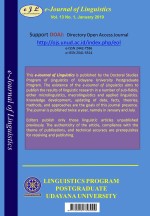Morphological Interference of Muna Language Speakers in the Use of Indonesian Language
Abstract
This study aims to examine the Muna language interference on the morphological aspects as a symptom of language that generally occurs in bilingual people. The influence of Muna language as a mother tongue and the difference between the morphological system of Muna and Indonesian is very possible for interference. This study was conducted with 20 participants from different community groups within the scope of Kecamatan Mawasangka, Kabupaten Buton Tengah. The data were collected using observation method with involved and uninvolved conversation, records and transcribing technique then analyzed using padan or Contrastive method to determine the presence of morphological interference.
The result showed that Interference in the aspect of affixation in this research occurs in the formation of the prefix {ka-}, prefix {kafo-}, prefix {ta-}, and confix {ka-...-i}. whereas in the aspect of reduplication the interference symptoms are found in the form of partial reduplication of the Muna language morphological system.
Finally, the suggestion in this research that it is expected that the readers can have better understanding about interference and be more careful in using language. so as to reduce interference or distortion in language.
Downloads
References
Alwasilah, Chaedar A. 1990. Linguistik: Suatu Pengantar. Bandung: Angkasa
Aso La. 2006. “Inovasi Internal dalam Bahasa Muna dan Perlakuan Kata-kata Serapan dari Bahasa Indonesia,”. A Thesis. Yogyakarta: FIB Universitas Gadjah Mada.
Arifin, Z., and Farid H. 2009. 1001 Kesalahan Berbahasa. Jakarta: Akademika Pressindo.
Arifin, Z., Junaiyah. 2009. Morfologi Bentuk, Makna, dan Fungsi. Jakarta: Gramedia Widiasarana Indonesia.
Awaluddin. 2010. “Afiks Pembentuk Verba Dalam Bahasa Muna”. A Thesis. Yogyakarta: FIB Universitas Gadjah Mada.
Bagea, A. 2011. “Kesinoniman Kata Dalam Bahasa Muna dialek Gulamas”. A Thesis. Kendari: FIB. Universitas Halu Oleo
Burhanuddin. 1979. Bahasa Muna. Peta Bahasa. Kemendikbud
Chaer, A. 2008. Morfologi Bahasa Indonesia (Pendekatan Proses). Jakarta: Rineka Cipta.
Chaer, A., dan Agustina, L. 2004. Sosiolinguistik : Perkenalan Awal. Jakarta: Rineka Cipta.
Hartmann, R.R.K., and F.C. Stork. 1972. Dictionary of language and linguistics. London: Applied Science.
Moleong, J. Lexy. 2010. Metodologi Penelitian Kualitatif. Bandung: Remaja Rosda.
Nazir, M. 2009. Metode Penelitian. Jakarta: Ghalia Indonesia
.
Nursaid dan Marjusman, M. 2002. “Sosiolinguistik” (Bahan Ajar). Padang: FBS UNP
Ohoiwutun, Paul.2007. Sosiolingistik. Jakarta: Kesaint Blanc
Ramlan, M. 2009. Morfologi Suatu Tinjauan Deskriptif. Yogyakarta: CV. Karyono.
Samsuri. 1985. Analisis Bahasa. Jakarta: Erlangga.
Sidu La, 1994. Fonologi Generatif Bahasa Muna. Palembang: MLI Komisariat Universitas Sriwijaya
Subroto, E. 2007. Pengantar Metode Penelitian Linguistik Struktural. Surakarta: UNS Press.
Sudaryanto. 1992. Metode Linguistik ke Arah Memahami Metode Linguistik. Yogyakarta: UGM Press.
Sudaryanto. 1993. Metode dan Aneka Teknik Analisis Bahasa: Pengantar
Verhaar. J.W.M. 2004. Asas-asas Linguistik Umum. Yogyakarta: Gadjah Mada University Press.
Hasiawati. 2018. Interferensi Morfologi Bahasa Bugis Terhadap Penggunaan Bahasa Indonesia Dalam Pembelajaran Bahasa Daerah. Makassar. UNEM Press

This work is licensed under a Creative Commons Attribution 4.0 International License











